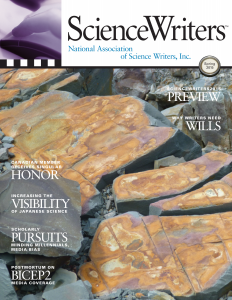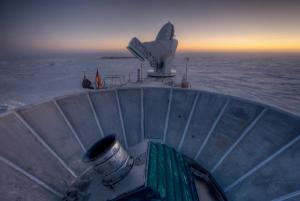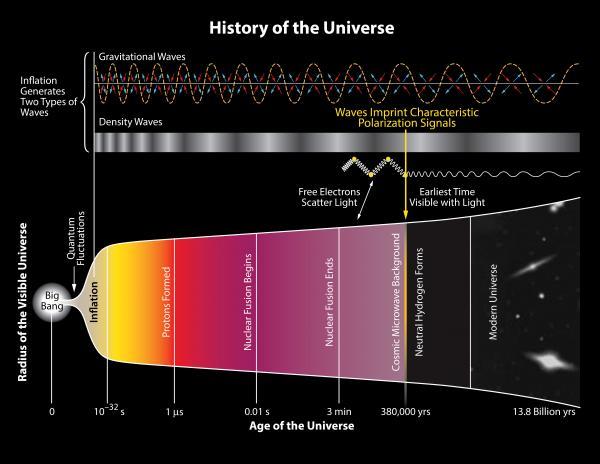What happens when you cross a beloved and compelling theory, a bevy of intensely competitive experiments on a highly technical subject, with a top-secret press conference, tight deadlines, and the desire to tell an exciting story? Perhaps you get the ascent and fall of BICEP2.
By Diana Steele
Rumors of a trip to Stockholm and front-page headlines around the world accompanied a viral, champagne-infused YouTube video when the BICEP2 (Background Imaging of Cosmic Extragalactic Polarization) team announced in March 2014 that they had seen the signal of gravitational waves from the early universe. The discovery was not only the first direct evidence for gravitational waves but also appeared to confirm the theory of inflation, that the universe expanded incredibly rapidly in the first fraction of a second of its existence.
These highlights were followed by an equally intense drubbing in the press over the course of the following year, culminating in an announcement early this year that BICEP2 probably didn’t actually see past the dust in our own galaxy.
Is it science at work, albeit in a painfully public manner? Or were scientists and science writers to blame for attaching too much credence to a compelling experiment? Or for not asking more probing questions when the results were first announced?
To explore these questions, I spoke to scientists, PIOs at the universities involved, and to reporters and editors who covered the story.
John Kovac, the lead investigator on BICEP2, spoke in November 2014 from the Amundsen-Scott South Pole Station, where he was deploying the next in a series of detectors for follow-up experiments. When asked about criticism that he and his team had gone directly to the press, rather than waiting until a paper had been peer-reviewed and vetted for publication, he said that his focus had been on communicating his team’s results to the scientific community. “We felt like we’ve been funded for many years,” he said, “and the results were long overdue.”Kovac and the team had considered presenting their results at a scientific conference, such as the American Astronomical Society. But the deadline for the January 2014 AAS conference slipped by. The next meeting which would have a large number of cosmologists present was not for many months. He was not sure of the timelines of competing experiments.
Kovac thought that a webcast and press conference seemed to be the best way to make sure that scientists, as well as journalists, had the chance to ask questions about the team’s results. It was a model the European Space Agency had used to release preliminary results from its space-based telescope, Planck, the previous year.
On March 17, 2014, the BICEP2 collaboration published a draft of their scientific paper, “Detection of B-Mode Polarization at Degree Angular Scales by BICEP2,” along with an extensive release of data from the experiment, to the arXiv, an online preprint server that serves primarily the physics, astrophysics, cosmology, and mathematics communities. The arXiv allows for an unusually open discussion of scientific ideas and experiments before an article appears in a printed publication. And on the morning of the 17th, they held a webcast scientific presentation for cosmologists.
“Only after that, we had a follow-on press conference, because we thought reporters might be interested,” he said, wryly.
Kovac perhaps underestimated the degree of attention the story would receive in the astrophysics community and in the press. He had anticipated dozens, or even hundreds, of people might be interested in accessing the server hosting the webcasts and the scientific data. After rumors about the content of the announcement began to circulate the Friday before the release, Kovac asked the IT department at Harvard if it would be capable of handling perhaps more than a thousand hits. “‘No problem,’” he said he was told. But on the morning of the 17th, “it crashed promptly.” In the first 24 hours, he said it received nearly 7 million hits.Kovac had worked with PIOs at the Harvard-Smithsonian Center for Astrophysics (CfA), where he is an associate professor, to draft the media strategy. Because of the intense competitiveness in the field of cosmic-microwave-background astronomy, secrecy was considered to be of utmost importance. The BICEP2 team alone has 47 collaborators at 16 institutions, with four principal investigators at four different universities. There are nine other ground-, balloon-, and space-based telescopes concurrently pursuing the same goal: peering deep into the early universe, looking for evidence of inflation. Many of the experiments share personnel or even workspace, such as the BICEP/Keck array telescopes and South Pole Telescope at the South Pole.
Reporters were not given access to the paper or even a press release ahead of time. Instead, on Thursday, March 13, CfA circulated an email to journalists announcing a press conference to be live-streamed on the 17th, but not announcing the topic or giving any background. Some reporters, fewer than a dozen, selected by Kovac and Harvard-Smithsonian PIO Christine Pulliam, were given a heads up as to what the story was about.
One of these was Michael Lemonick, who wrote about BICEP2 for Time magazine and Scientific American. Lemonick, knowing he would be completely out of touch by March 17, traveling in Bhutan, reported and wrote his story ahead of the press conference. He said Harvard asked him not to speak to any scientists who had not already seen the paper, and gave him the names of a few cosmologists who had reviewed the results and agreed to speak to the press. Lemonick said they asked him not to speak to anyone at Princeton, where Lemonick lives. “At the time, I thought it was probably because Princeton is a competitor,” he said. “And that seemed like a reasonable thing.”
“They told me who the people were, and I said to myself, ‘That’s a fine group of outsiders, OK.’” He wrote his story using only the sources Harvard provided. He later regretted it. A cosmologist at Princeton was the one who eventually pointed out to him, “‘Did you not realize that everybody they gave you to talk to is a theorist? Who has probably never done an experiment in his life, and is entirely unqualified to judge the validity of an experiment?’” he recalled. “No, I did not even think of that for a second, and I should have.”
Here’s where the beloved and compelling theory comes into the story. In the late 1970s and early 1980s, theorists Alan Guth and Andre Linde, now at MIT and Stanford University, respectively, developed a theory known as “inflation” to explain how the universe came to be so incredibly uniform—the same in all directions—and at the same time lumpy, with clusters of matter that form galaxies and large structures. The theory of inflation holds that the universe expanded so incredibly rapidly that the small quantum-scale fluctuations in the early universe became imprinted on the fabric of the cosmos. When inflation was first proposed, no one thought there would ever be any way of confirming its predictions through experiments.But both theory and experiment have advanced in the decades since to the point that many experiments are currently looking for signals corresponding to predictions made by different inflation models. BICEP2 appeared to offer the first confirmation that inflation actually happened. The press release was boldly titled “First Direct Evidence of Cosmic Inflation.”
“For theorists it was a big deal,” said Faye Flam, who wrote about the coverage of BICEP2 for the Knight Science Journalism Tracker. “They said things like, ‘This is the biggest thing that will be discovered in my lifetime, that has been or will be.’ ‘The discovery of the century.’” She said theorists can be quite skeptical, but when you interview a theorist and “they say ‘Oh, this is huge!’ you know it’s huge. Or would be huge if it were true.”
Most of the stories contained phrases like “the results need to be confirmed,” or “if it’s real.” But Lemonick lamented, “I wish I had talked to other experimentalists who work on this problem,” because “people who are knowledgeable about this sort of experiment are the people you talk to, and I didn’t.”
He added, “The excitement generated by a super-secret, ‘for-your-eyes-only’ announcement, doled out to a few reporters, and a mysterious announcement of a major press conference coming up at Harvard … there was a real drumroll.”
Most reporters only had a few hours to wrestle with the material presented in the paper and at the press conference, which included the four PIs and one exuberant theorist, Mark Kamionkowski, along with Guth and Linde as invited guests in the audience. A Google search reveals more than 500 articles or blogs published later that same day, and a further 500 published on the 18th.
The print version of the BICEP2 paper was published in the journal Physical Review Letters in June, but by that time, discussion through follow-up publications on the arXiv and through social media and in the press, had already begun to cast doubt on the results. Critics, including Princeton cosmologists Paul Steinhardt and David Spergel, were quick to point out that BICEP2’s detection of the signal from gravitational waves could instead be entirely due to dust within our own galaxy. Eventually, a cross-correlation with the space-based Planck telescope showed that the signal did not significantly rise above the background of dust, which also emits polarized radiation in the same frequency range.
Kovac maintains that his team always considered that dust was a possible contaminating factor, but sufficient data were not publicly available at the time to constrain the contributions of dust to the signal. The press release gave scant mention to it, saying of the researchers, “They also considered whether dust in our galaxy could produce the observed pattern, but the data suggest that is highly unlikely.”
Lemonick says at the time the researchers didn’t emphasize the ways in which their experiment could be wrong, and “downplayed what others ended up thinking was the shakiness of their interpretation.” He added, “I’ve been in enough editorial meetings at Time magazine, where there’s a news story that is really, really important if true. And so the question is, ‘How much do we emphasize the tentative nature of it?’ It’s very easy to be less than absolutely hard-nosed about your own product where an exciting announcement or an exciting news story would make a greater splash than a dull one.”
And “I wanted to write an exciting story, too!”
Diana Steele is a freelance science writer. She read the front-page headlines about BICEP2 while in Berlin. Although she did not write about this story as it unfolded, she has covered the field of cosmology in the past, both as a journalist and a PIO at the University of Chicago. Her trip to the South Pole in 1995 introduced her to the experiments and people involved in searching for the origins of the universe from that unique location.
Champagne with that?
Coincidentally, Stanford University is the home of one of the four PIs on the BICEP2 experiment, as well as one of the theoretical architects of inflation, Andre Linde.
Stanford PIO Bjorn Carey knew that Linde was packing for a weeklong vacation in the Caribbean, from which he would return March 16. In order for Linde to be in Cambridge for the BICEP2 scientific webcast and press conference on the 17th, he would have to be told about the results before he left.
Carey decided to bring a videographer along when BICEP2 co-PI Chao-Lin Kuo, then an assistant professor at Stanford, told Linde about the team’s purported confirmation of the theory of inflation. The result was a 2½-minute video showing an ecstatic Linde drinking champagne with his wife and Kuo, which Stanford published to YouTube on the day of the press conference. In the months since, it’s had nearly three million views.
Kovac didn’t know about the video before it was published to YouTube. “I was, I think, the two-millionth viewer,” he said later. Christine Pulliam, of the Harvard-Smithsonian Center for Astrophysics, who was coordinating the PR effort for the 16-institution collaboration, didn’t know about Stanford’s video either.
Whether or not Harvard’s Kovac and MIT’s inflation theorist, Alan Guth, shared a bottle of champagne when they met is a matter known only to them. Asked later if she wished she had brought along a videographer to their meeting, Pulliam said in an email that she wasn’t there and wouldn’t have considered it.
“That video did not contain,” Kovac said, “the cautions and caveats that we had discussed as a collaboration that we would use when we described the nature of our detection and the uncertainties in its interpretation.”
Stanford capitalized on a PR opportunity, but it proved to be somewhat of an embarrassment to the collaboration when BICEP2’s “confirmation” of inflation disappeared behind the dust.
Despite prominent banners at the beginning and end of the video proclaiming it to be a production of the Stanford University News Office, many people apparently conflated it with the BICEP2 collaboration. At least one reporter, writing for Nova Next, wrote extensive profiles of Andre Linde and Chao-Lin Kuo, leaving Alan Guth and John Kovac in the dust.
(NASW members can read the rest of the Spring 2015 ScienceWriters by logging into the members area.) Free sample issue. How to join NASW.




